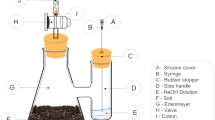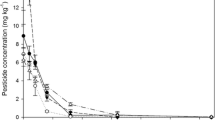Abstract
In the present work, the influences of several organic fertilizer treatment regimens were compared as to their slowing down effect on aldicarb soil metabolism in a sugar beet crop. The organic fertilizers treatment schemes had been repeatedly applied in the past 30 years, according to a 3-year rotation cycle. The following organic fertilizers treatment regimens—which are the main ones used in the agronomy practice—were compared: Treatment 1: no organic fertilizer at all; treatment 2: 40 tons cow manure ha−1; treatment 3: 40 tons pig slurry ha−1 + green manure + crop wastes; treatment 4: green manure + crop wastes; treatment 5: straw cereal wastes alone. A sugar beet crop was sown in April 1991, 1 kg aldicarb ha−1 being applied in granulates in the sowing furrow. During the 2.9 first crop months, the soil half-lives of the sum of the insecticide S- +SO- +SO2-aldicarb in the sowing line in the 0–25 cm surface soil layer were 21.6, 44.4, 39.6, 35.7, and 30.3 days in the treatments 1, 2, 3, 4, and 5 treated plots, respectively. The organic fertilizers soil treatments thus increased the persistence of the total insecticide compounds soil concentrations, and probably also the insecticide protection efficiencies. Comparison of the results obtained here with the ones previously obtained with other crop trials, herbicides and soil insecticides, suggests that the soil organic matter is the most efficient to slow down the insecticides soil biodegradation, compared to the old humus originating from the organic fertilizers treatments made more than one year ago. After the three first sugar beet crop months, the effect of the organic fertilizers treatments on the aldicarb and its insecticide metabolites soil persistences disappeared, their soil concentrations become very low and similar in the organic fertilizers treated and untreated control plots.
Similar content being viewed by others
References
Coppedge JR, Lindquist DA, Bull DL, Dorough HW (1967) Fate of 2-methyl-2-(methylthio-propionaldehyde O-(methylcarbamoyl) oxime (Temik) in cotton plants and soil. J Agric Fd Chem 15:902–910
Honnay JP (1990) Scientific Advisor at the Institute for Applied Research in Industry and Agronomy, IRSIA-IWONL, Belgium
Rouchaud J, Gustin F, Benoit F, Ceustermans N, Gillet J, Van de Steene F, Pelerents C (1992a) Influence of cow manure and composts on the effects of chlorfenvinphos on field crops. Arch Environ Contam Toxicol 22:122–129
Rouchaud J, Gustin F, Van Himme M, Bulcke R, Sarrazyn R (1992b) Soil biodegradations of imazamethabenz and of its herbicide acid metabolite in field wheat crops and in sugar beet replacement crops. Pest Sci (in press)
Author information
Authors and Affiliations
Rights and permissions
About this article
Cite this article
Rouchaud, J., Gustin, F., Roisin, C. et al. Effects of organic fertilizers on aldicarb soil biodegradation in sugar beet crops. Arch. Environ. Contam. Toxicol. 24, 67–74 (1993). https://doi.org/10.1007/BF01061090
Received:
Revised:
Issue Date:
DOI: https://doi.org/10.1007/BF01061090




